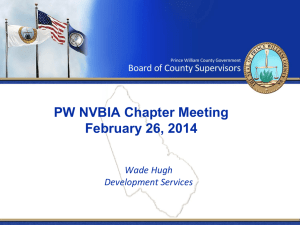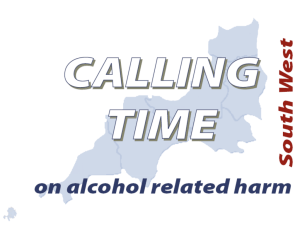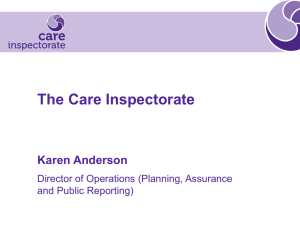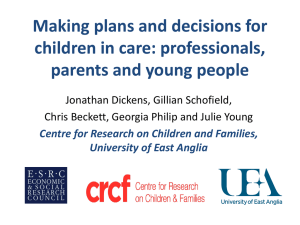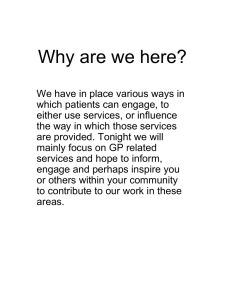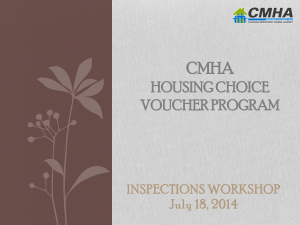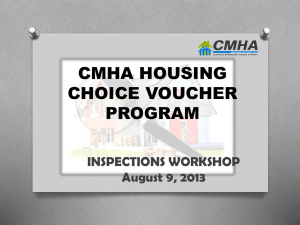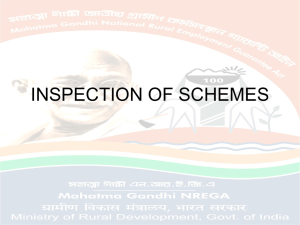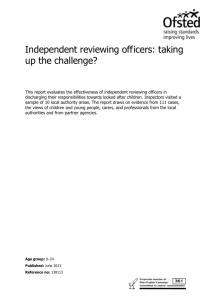Ofsted Inspection - Salford City Council
advertisement
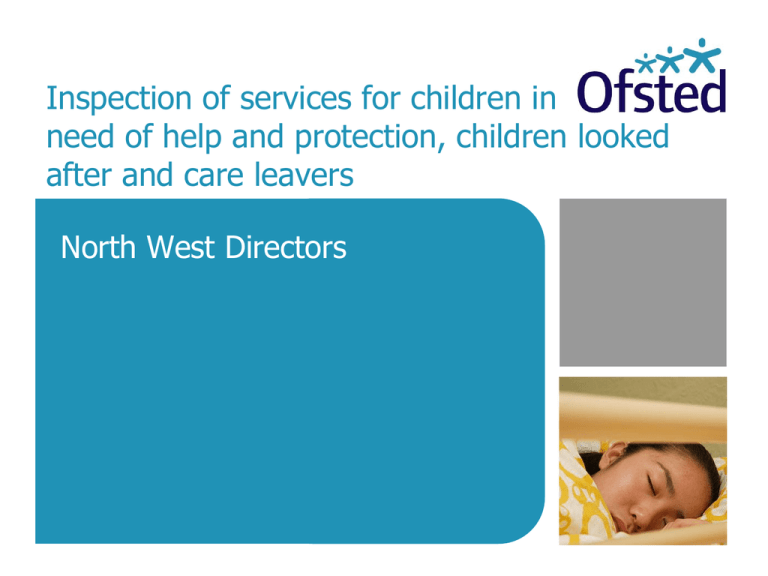
Inspection of services for children in need of help and protection, children looked after and care leavers North West Directors History Working towards a new framework with other inspectorates (represented a significant challenge) Major support for one children looked after inspection Pilots undertaken for multi-agency inspections and looked after children inspections. (pilots showed that both could be challenging to deliver) Positive feedback on inspection of child protection arrangements Add presentation title to master slide | 2 What did this tell us? Fragmenting inspection about what happens to children who need help, protection and possible care – not helpful One (limiting) word to describe a complex local system not the right thing to do – sector views Separate multi-agency inspections – intended start in April and June – deferred. Press release in April, agreed with other inspectorates New single inspection (child protection, looked after children (adoption and fostering) and care leavers – starting in September – pilots in June Continuing to work with other inspectoratesthrough a project group and regular Chief Inspector meetings What’s going on? Developing a single inspection- our journey to here Taking the best learning from the three inspections More than ‘adding’ together- the right profile for all the children and young people in scope and the opportunities this gives us Focus on children and young people’s experiences- remains key methodology Consultation on the planned changes underway Add presentation title to master slide | 4 Scope those children and young people at risk of harm (but who have not yet reached the ‘significant harm’ threshold) and for whom a preventative service would provide the help that they and their family need to reduce the likelihood of that risk or harm escalating and reduce the need for statutory intervention (EARLY HELP) those children and young people referred to the local authority, including those for whom urgent action has to be taken to protect them; those subject to further assessment; and those subject to child protection enquiries (CRA) those who become the subject of a multi-agency child protection plan setting out the help that will be provided to them and their families to keep them safe and to promote their welfare (CP PLAN) Add presentation title to master slide | 5 those children and young people who have been assessed as no longer needing a child protection plan, but who may have continuing needs for help and support (POST CP PLAN) those children and young people who are receiving (or whose families are receiving) social work services where there are significant levels of concern about children’s safety and welfare, but these have not reached the significant harm threshold or the threshold to become looked after (CHILDREN IN NEED) Add presentation title to master slide | 6 those children and young people accommodated under section 20 and those ‘in care’ during or as a result of proceedings under section 31 of the Children Act 1989 and those accommodated through the police powers of protection and emergency protection orders (ACCOM/ CLA) those children and young people who are being, or have been, looked after under the Children (Leaving Care) Act 2000 (eligible, relevant and former relevant young people) (care leavers) those children and young people who have left care to return home, or are living with families under a special guardianship order, residence order or adoption order (permanence) Add presentation title to master slide | 7 The judgements we will make on the pilots The overall effectiveness of services and arrangements for children who need help and protection, children looked after and care leavers. This is a cumulative judgement derived from: The experiences and progress of children who need help and protection. The experiences and progress of children looked after and achieving permanence including graded judgements on: Adoption performance The experiences and progress of care leavers Leadership, management and governance including: Separate grade The effectiveness and impact of the Local Safeguarding Children Board Add presentation title to master slide | 8 The new framework – overview 3 key judgements – Protecting children; Looked after children and Achieving Permanence; Leadership, Management and Governance 3 graded judgements – adoption, care leavers, LSCB Inadequate in any key judgement limits overall effectiveness to inadequate 4 point judgement scale – inadequate - outstanding New ‘requires improvement to get to good’ grade. No longer have a grade of ‘adequate’ There is a qualifier for ‘leadership’ in inadequate places Graded judgements influence but are unlikely to ‘limit alone’ Sets out Ofsted’s role in improvement straight an inspection A new evaluation schedule Practice and impact brought together ‘Requires improvement to be good’ Key judgements and graded judgements Defining our expectations of ‘good’ - a new good Generic components to ‘outstanding’ Widespread or serious = inadequate in key judgements Add presentation title to master slide | 10 The methodology Week one timeline Pre inspection preparation- small team Wednesday- lead and small team on site after midday Thursday- children and young people information available by midday Friday- leave site by 2pm Tuesday- lead calls- sets up the inspection and outlines what we need and timeframes Add presentation title to master slide | 11 Case file auditing- 12 children and young people of the 25 cases tracked Six children and young people in need of help and protection to include: one child under three years; one adolescent; all will have been subject to an initial child protection conference and at least two of the cases will be post review; One child that has been subject to an initial child protection conference but who did not become subject to a child protection plan; Four children looked after to include: at least one child who has a plan for adoption; one child who has recently returned home in the last three – six months Two care leavers: one relevant and one former relevant. Add presentation title to master slide | 12 Remainder of children and young people tracked (total of 25): Criteria to be used outlined in handbook; Observations of practice- will inform; Informing the LA in week two so most records prepared. In addition: Four foster carer records (minimum)- related where possible; Four prospective adopter records (minimum) related where possible; Clarity about difference between case tracking and sampling (around a further 50). Add presentation title to master slide | 13 The methodology Intensive case tracking forms the early part of the inspection Working across judgements- why? What does this mean?- understanding children and young people’s experiences. Each social care HMI will track at least five cases from across the scope and sample further cases as the key lines of enquiry emerge. Role of the cross remit specialist (ELS): tracking the experiences of children and young people in early help, the education of looked after children and care leaver’s access to education, employment and training. Add presentation title to master slide | 14 Extended team meeting in week three must happen (first on-site week for full inspection team) Confirm good practice Identify further key lines of enquiry Shared understanding of children and young people’s experiences- identify practice and leadership, management and governance issues Children’s experiences are at the core of the inspection. Add presentation title to master slide | 15 The judgements Include a paragraph that describes the judgement Inadequate- different definitions for the graded judgements Define good Requires improvement- not yet good Inadequate- ‘widespread and serious’ across key judgements Add presentation title to master slide | 16 Report formatbeing clear and authoritative Piloting new report style Much more concise style of writing Accessible summary as part of main report to replace the children and young people’s version Add presentation title to master slide | 17 Next steps Evaluating the pilots (2)opportunities to feedback and learn what has worked well and what has worked less well. Opportunities to share learning from the pilots Implementation in after September Add presentation title to master slide | 18 Supporting improvement survey work and good practice case studies Ofsted has always sought ways to support improvement Messages from inspection via the annual report The good practice website (list of what is available need more) Survey work and thematic inspections Add presentation title to master slide | 19 Thematic inspections by Ofsted 6-8 social care thematic inspection reports published per year Themes selected following consultation with sector Safeguarding and LAC inspections identified Most recently published Effectiveness of IROs thematic inspection published June 2013 What about the children (a look at how well adult and children’s services work together) published March 2013 Missing children (a look at practice for children who run away) published February 2013 Planned or being considered Long term neglect Family Justice Commissioning Post permanence support Early help Out of borough placements Key findings IRO Overall, the pace of progress in IROs taking on the enhanced responsibilities was too slow in most local authorities Oversight of care plans not sufficiently robust – IROs didn’t always challenge delays for children strongly enough Caseloads were too high in most local authorities The views of children not always fully taken into account Formal dispute resolution processes were in place, but not always well understood or applied Key findings (cont’d) The IRO role in challenging overall performance as corporate parents was under-developed: IRO annual reports, where they were existed, were nearly all weak Few IRO services had forged strong links with CiC Council or with senior corporate parents The independent challenge that IROs can offer was welcomed by senior managers Management oversight of IRO service quality not strong enough in most local authorities Key findings (cont’d) The effectiveness of IROs would not be easily improved by removing them from the employment of local authorities – there is much scope for improvement under the current arrangements Recommendations Local authorities should: Take urgent action to implement in full the revised IRO guidance and ensure that: IROs have the capacity to undertake all aspects of their role effectively Management oversight of IROs is sufficiently robust A publically accessible annual report is produced, setting out the quality of corporate parenting and care for looked after children and including information on IRO caseloads Supporting improvement Good practice case studies On website good practice case studies individual examples of good practice seen by inspectors. Forty examples on site more to be added. Statistics and analysis Data teams now providing regular statistical updates. Inspection outcomes across the sector and regional profiles. So North West has the highest number of any region of regulated services accommodating many of the countries children looked after. Add presentation title to master slide | 25 Supporting improvement other tools Statistics and analysis of North W3aest Children’s home 71% good or better slightly worse than national average 72%. Best region South West at 78% Local authority Child Protection 48% good or better. Better than England average. Best region London at 67% Adoption agencies 86% good or better. Better than England averages 79%. Best region South West at 90% Fostering services 72% worse than national average 78%. Best regions NEYH and East of England at 83% Local authority children looked after 61%better than average 54%. Best region East Midlands at 67% Add presentation title to master slide | 26
